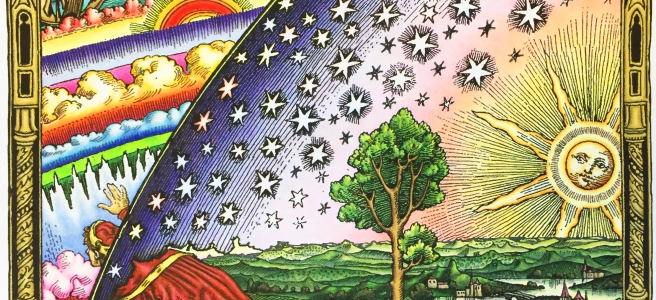Some readers of my review of Gerald Heard’s The Riddle of the Saucers might wonder why I bothered, given my obvious distaste for the book, and why they should bother, given that, considered ufologically, the book’s value is strictly historical, really adding nothing new to solving that riddle of the book’s title.
In the first place, the review is part of one of the projects underway here at the Skunkworks: to read and review all the Ufo books mentioned in Jung’s Flying Saucers, reviews that will be collated under the category “Jung’s Ufological Bookshelf”. Aside from being an interesting task in itself, the project will contribute to better understanding Jung’s reflections on the subject, and, more importantly, begin the process of concretely articulating the material that Jung develops, connecting it, for instance, to his alchemical studies.
As should be obvious to anyone reading this blog with any attention, my central concern is to reveal the ways the UFO illuminates or takes up in its vortex (considered both poetically and para-scientifically) galaxies of other concerns, including our most pressing, social, ecological, and “spiritual” (Geistig), all in the hopes of someday presenting the work as a book or, ideally, a poem. (Though, I fear, the project will more likely end up a textual version of Jonathan E. Caldwell‘s…).
I observed already in my review the prescience of Heard’s imagining the ufonauts to be insects.  In the Alien Abduction literature, the ETs are often described as being insectoid in various ways, and the figure of the Mantis is prevalent. So, in the context of the development of the myth (if not the hard core of the mystery), Heard’s book is, intentionally or not, significant.
In the Alien Abduction literature, the ETs are often described as being insectoid in various ways, and the figure of the Mantis is prevalent. So, in the context of the development of the myth (if not the hard core of the mystery), Heard’s book is, intentionally or not, significant.
But consider Heard’s description (150) of how the Martian Super-Bees might appear:
A creature with eyes like brilliant cut-diamonds, with a head of sapphire, a thorax of emerald, an abdomen of ruby, wings like opal, legs like topaz.
From a strictly literary critical, stylistic or philological, perspective, this description is tired, but from a poeticreative one, much more suggestive.
Within the context of the myth as a whole, the insectoid form of the Super-Bee will rime with a more general insectoid theme that reappears, at least, in the context of Alien Abduction stories, as noted. Moreover, the red of the ruby, green of the emerald, and pure white light of the diamonds rimes with the colours of lights reported, for example, on the Phantom Airships of 1896/7. That UFOs are often described as flashing or strobing multicoloured lights or to be scintillating (like gems might be said to) winds another thread into the aesthetic texture.
However doubtful it is that Ezekiel’s Chariot is analogous to a modern-day UFO, that Ezekiel’s vision is read as a premodern sighting report makes it, too, part of the myth. (Parties, skeptical and curious, are encouraged to consult (Milton scholar!) Michael Lieb’s Children of Ezekiel: Aliens, UFOs, the Crisis of Race, and the Advent of the End Time that unfolds the developing meaning of Ezekiel’s Chariot from the prophet’s own times to the present). In this context, it becomes not insignificant that “the appearance of the wheels [of the chariot] and their work was like unto the colour of a beryl” (Ezekiel I.16) and the throne on the chariot has “the appearance of a sapphire stone” (Ezekiel I.26). This happenstance rime is more suggestive than it might seem offhand.
Jung’s Ufo study is artistically compelling by its associating aspects of the Ufo visionary rumour not only to the concrete historical horizon within which flying saucers first appear but to Alchemy, that vast literature that functions as a subliminal inspiration in the works of Shakespeare, Blake, Yeats, Pound, H.D., Robert Duncan, and others. A few minutes of paging through the indices of Jung’s Alchemical Studies and Mysterium Coniunctionis turn up allusions to a description of
the sapphire stone, [which] takes on divers colours from the highest powers, and works in created things now in one wise, now in the contrary, administering at times good, at others evil, now life, now death, now sickness, now healing, now poverty, now riches (Mysterium Coniunctionis, 447)
taken, unsurprisingly from the Kabbala denudata. One of the goals of Chinese Alchemy was the creation of “the diamond body” (Alchemical Studies, 21). And, if one, understandably, were to associate the Latin lapis (as in the Alchemical expression Lapis Philosophorum, Philosopher’s Stone) with the constellation of associations generated by just some of the precious stones that go to make up Heard’s Martian Super-Bee, one might be forgiven to call to mind the Alchemical “Visita Interiora Terra Rectificanto Inveniens Occultum Lapidem“: Visit the interior of the earth and rectifying [purifying] you will find the hidden stone.
Hear, the most preliminary tracing of associations leads us to the Hollow Earth, another famous dimension of the myth, as one putative origin of the UFOs (which rimes, too, with other associations, underground bases, or Earth Lights and ELF waves (which pun, in turn, brings in the whole dimension of Faery lore…)). Along with the depths of the earth’s oceans, the deeps of space, or even the depths of past or future time, or equally infinitely distant and near other dimensions, all these homes of the Other, all Other places, rime with Jung’s Unconscious (the psychoanalytic Other)….
Nor should one eschew the phonemic near rime of lapis and ‘laugh’ or the interlinguistic rime with French lapin….As Whitman said, “the theme (or, in this case, a kind of rabbit hole (!)) has vista”….


